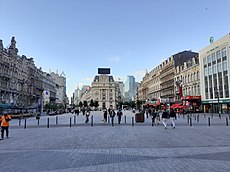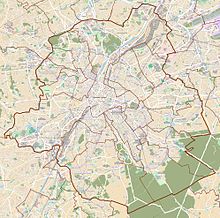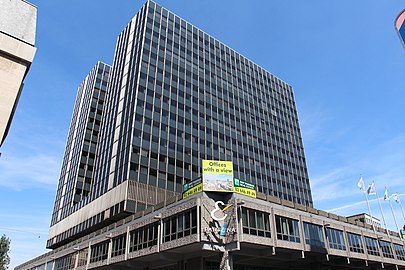Place de Brouckère
 The Place de Brouckère/De Brouckèreplein in Brussels | |
 Location within Brussels | |
| Location | City of Brussels, Brussels-Capital Region, Belgium |
|---|---|
| Quarter | Marais–Jacqmain Quarter |
| Coordinates | 50°51′05″N 04°21′09″E / 50.85139°N 4.35250°ECoordinates: 50°51′05″N 04°21′09″E / 50.85139°N 4.35250°E |
| Construction | |
| Completion | c. 1870 |
The Place de Brouckère (French) or De Brouckèreplein (Dutch) is a major square in central Brussels, Belgium. It was created following the covering of the river Senne (1867–1871), replacing the Temple of the Augustinians, which was demolished in 1893. It is named in honour of Charles de Brouckère (1796–1860), a former mayor of the City of Brussels and professor at the Free University of Brussels, who played a great political role during the Belgian Revolution of 1830.
The Place de Brouckère is located in the perspective of the Boulevard Émile Jacqmain/Émile Jacqmainlaan and the Boulevard Adolphe Max/Adolphe Maxlaan to the north, forming a "Y" crossroad, and the Boulevard Anspach/Anspachlaan to the south.[1] It is served by the metro and premetro (underground tram) station De Brouckère on lines 1, 3, 4 and 5.
The area around the square is characterised by the presence of theatres, a large cinema, hotels and restaurants, as well as some of the city's most important entertainment venues and shopping streets.
History[]
The Place de Brouckère was laid out following the covering of the river Senne (1867–1871), as part of the major urban works by the architect Léon Suys under the tenure of the then-mayor of the City of Brussels, Jules Anspach.[2][3] It took the place of the former Temple of the Augustinians.[4] This church, built at the beginning of the 17th century in the Brabantine Baroque style, was the only remaining part of a convent destroyed in 1796 by French revolutionaries. The work to cover the river, which nearly surrounded the church, preserved the integrity of the building at great trouble and expense, but it was finally demolished in 1893, its style no longer popular with the people and its presence unsuitable for the area. Its facade's masonry, however, was preserved, being disassembled and reconstructed as the facade of the Church of the Holy Trinity in Ixelles.[5]

In the centre of the square, left empty by the destruction of the church, a fountain-obelisk dedicated to the memory of Jules Anspach was erected.[6] Inaugurated in 1897, the Anspach Fountain was removed in 1973 to make way for access to the metro station. The authorities had promised to put it back in place after the works, but it was eventually reinstalled in May 1981 in a basin that occupies the space between the Quai aux Briques/Baksteenkaai and the Quai au Bois à Brûler/Brandhoutkaai in the Sainte-Catherine/Sint Katelijne neighbourhood, some 700 metres (2,300 ft) from the Place de Brouckère.[7]
For its role as a prestigious central square, its triangular configuration, and the nearby presence of cinemas and theatres (including the former Eldorado cinema, as well as the National Theatre on the Boulevard Émile Jacqmain/Émile Jacqmainlaan), the Place de Brouckère could have been compared to a mini-Broadway in Brussels from the 1930s to 1960s, when large illuminated advertisements lit the square from the rooftops. Its appearance back then earned it international fame, as it hosted one of the tourist pavilions of the 1958 Brussels World’s Fair (Expo '58), built especially for the occasion.[8]
If today almost all the signs have disappeared from the Place de Brouckère (with the exception of the Coca-Cola sign on the roof of the Hotel Continental), various attempts at revitalising the square are underway to bring it back to its heyday. In 2014, the City of Brussels' then-mayor, Yvan Mayeur, declared his wish to turn the square into "A Times Square in the centre of Brussels".[9] Since 29 June 2015, the square has been pedestrianised, as part of a large pedestrian zone in central Brussels (Le Piétonnier). On that occasion, it was partially restored to its original appearance and was repaved.[10]
Places of interest[]
The Place de Brouckère is dominated by fin de siècle buildings, but modern colossi (most notably the Philips Tower and Monnaie Center) have also risen on its southern side since the 1960s. The focal point is the Hotel Continental (1874) by the architect Eugène Carpentier, a building well recognisable to the people of Brussels because of the large luminous Coca-Cola sign on its roof.[11] This roof, which was originally topped with an imposing copper sculpture representing The Feast by Louis Samain, was considerably simplified following the fire that ravaged the building in 1901.[12]
The square is home to the Hotel Metropole (1895) by the architect Antoine Trappeniers, where the first Solvay Conference on Physics and on Chemistry was held in the autumn of 1911.[13][14] On the opposite side stands the former Eldorado cinema (1906), now the UGC De Brouckère, with its Grand Room featuring African-themed Art Deco motifs designed by the architect Marcel Chabot in 1931–32. This cinema complex has been listed as a protected monument since 28 April 1994.[15] On the south-eastern side of the square are two covered shopping galleries; the Anspach Center and the Mint Center.
The Anspach Fountain is a granite fountain-obelisk surmounted by a bronze effigy of Saint Michael, the patron saint of the City of Brussels. This monument stood exactly in the axis of the Boulevard Anspach/Anspachlaan, like a regulator of traffic at the birth of the fork between the Boulevard Émile Jacqmain/Émile Jacqmainlaan and the Boulevard Adolphe Max/Adolphe Maxlaan. Inseparable from the monumental perspective of the boulevards—and yet moved following the works of the metro—it is, through its dedication and former location, a tribute to Anspach.[6]

Hotel Metropole (Trappeniers, 1872)
Café Metropole (Bordiau, 1872)
Hotel Continental (Carpentier, 1874)

Philips Tower (1967–1969)

Monnaie Center (1967–1971)
In popular culture[]
Music[]
- The Belgian-born French musician Django Reinhardt composed and performed a jazz song entitled Place De Brouckère (1942).
- The Place de Brouckère is referenced amid an evocation of the Belle Époque by the Belgian singer Jacques Brel in the song Bruxelles (1962).
- The square is also mentioned in a song entitled Bruxelles by the Dutch singer Dick Annegarn (1974).
See also[]
| Wikimedia Commons has media related to Place de Brouckère/De Brouckèreplein. |
- Royal Theatre of La Monnaie, an opera house close to Place de Brouckère
- Central Boulevards of Brussels
- Belgium in "the long nineteenth century"
Notes[]
References[]
- ^ Eggericx 1997, p. 5.
- ^ Demey 1990, p. 65.
- ^ Map of Suys' Proposal. City Archives of Brussels: P.P. 1.169
- ^ Eggericx 1997, p. 30.
- ^ "Ixelles - Église paroissiale de la Sainte-Trinité - Parvis de la Trinité - VAN YSENDIJCK Jules Jacques". www.irismonument.be (in French). Retrieved 2018-05-19.
- ^ Jump up to: a b Eggericx 1997, p. 31.
- ^ "Les fontaines dans la région de Bruxelles-Capitale". eurobru.com. 2007. Archived from the original on October 7, 2007. Retrieved November 8, 2007.
- ^ "Flashback : revivez l'époque où De Brouckère était Times Square !". Bruxelles Secrète (in French). 2021-02-08. Retrieved 2021-07-17.
- ^ Colleyn, Entretien>Mathieu. "Yvan Mayeur: "Un Times Square au centre de Bruxelles"". La Libre.be (in French). Retrieved 2021-07-17.
- ^ "Project. Pedestrian zone". www.brussels.be. 2017-02-28. Retrieved 2018-12-15.
- ^ "Bruxelles Pentagone - Hôtel Continental - Place De Brouckère 41 - Boulevard Emile Jacqmain 1-1a-1b-3-5-7-9-11-13-15-19 - Boulevard Adolphe Max 6-10-12-22-26 - Rue Saint-Michel 1-5 - CARPENTIER E." www.irismonument.be. Retrieved 2019-07-28.
- ^ Eggericx 1997, p. 14.
- ^ "Bruxelles Pentagone - Hôtel Métropole - Place De Brouckère 31 - TRAPPENIERS A." www.irismonument.be. Retrieved 2019-07-28.
- ^ "Brussels City Centre Hotels | Hotel Metropole Brussels - About | Art Nouveau Hotel Brussels". www.metropolehotel.com. Retrieved 2018-05-18.
- ^ "Bruxelles Pentagone - Ancien cinéma Eldorado - Place De Brouckère 34-38, 40-42-44-46". www.irismonument.be. Retrieved 2019-07-28.
Bibliography[]
- Demey, Thierry (1990). Bruxelles, chronique d’une capitale en chantier (in French). I: Du voûtement de la Senne à la jonction Nord-Midi. Brussels: Paul Legrain/CFC. OCLC 44643865.
- Eggericx, Laure (1997). Bruxelles, ville d'Art et d'Histoire (in French). 20: Les Boulevards du Centre. Brussels: Centre d'information, de Documentation et d'Etude du Patrimoine.
- Squares in Brussels
- City of Brussels
- Protected heritage sites in Brussels
- 19th century in Brussels
- Brussels geography stubs





